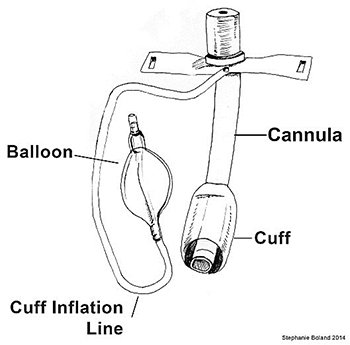Parts of a Tracheostomy
Parts of a Tracheostomy
View a video that explains the parts of a tracheostomy tube.
View a video that explains the different types of tracheostomy tubes.
Tracheostomy tubes come in various sizes and are made of different materials. Of the many types that exist, the most common brands at Golisano Children’s Hospital are: Shiley™ and Bivona®.

- Tracheostomy tube is inserted and will remain in the stoma (hole)
- Tube length and thickness are different for each child. For small children and infants, the tracheostomy tube is typically a single cannula tube.
- Larger size tracheostomies for older children and adults may have a double cannula tracheostomy tube. With this type of tracheostomy, the outer tube acts as a permanent tube which remains in the stoma. The inner cannula acts as a removable liner. The inner cannula can be removed and cleaned, or discarded and replaced.
- Flange (faceplate) rest on the neck. It extends from either side of tracheostomy tube. This is where ties are attached.
- Obturator comes with each type of trach tube. It is used to guide the outer tube into the stoma during insertion. It is removed immediately after the trach tube is secured in place.
- Ties attach to the flanges. They tie around the child’s neck to keep the trach tube in place.
 Ties need to be tight. Allow only one finger/fingertip to fit between ties and neck.
Ties need to be tight. Allow only one finger/fingertip to fit between ties and neck.  The cuff is a soft balloon at the end of the trach tube. Not every tube has a cuff. It’s most often used for children on ventilators (breathing machines). The cuff can be inflated with water or air, depending on the type of tube your child has. When cuff is inflated, mechanical ventilation can occur. When cuff is deflated, air is allowed to pass around the tube.
The cuff is a soft balloon at the end of the trach tube. Not every tube has a cuff. It’s most often used for children on ventilators (breathing machines). The cuff can be inflated with water or air, depending on the type of tube your child has. When cuff is inflated, mechanical ventilation can occur. When cuff is deflated, air is allowed to pass around the tube.- Bivona® Flextend Tracheostomy tubes have an extra extension between the hub and the neck plate. There is a picture of a triangle on the trach adapter that must be facing up towards the ceiling. When it is facing up, it ensures that the trach tube is not twisted.